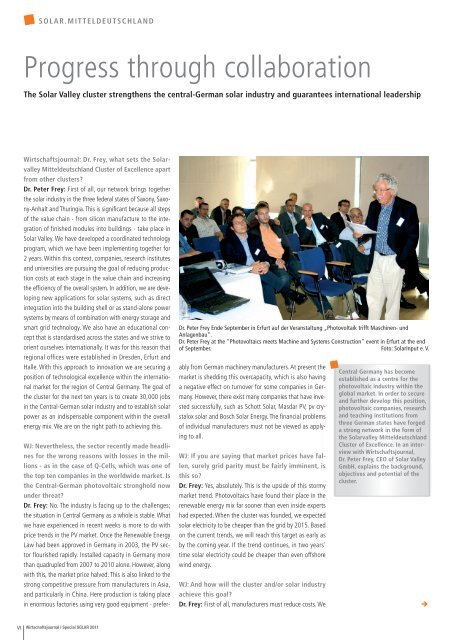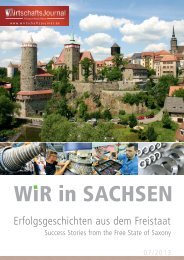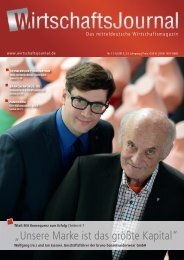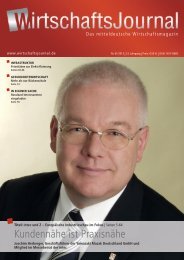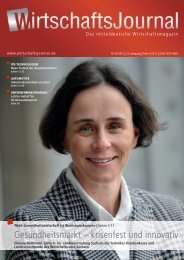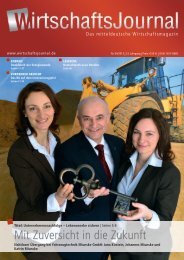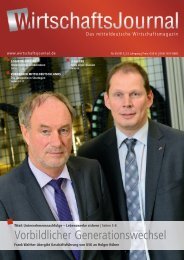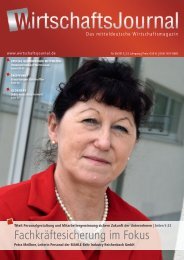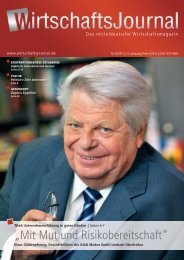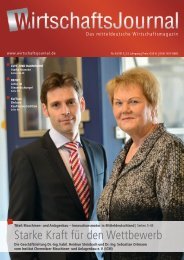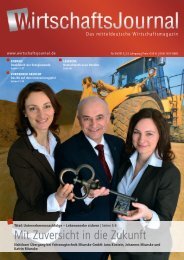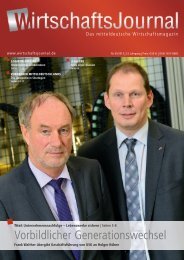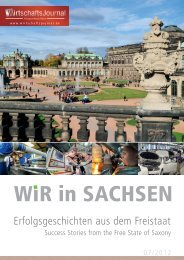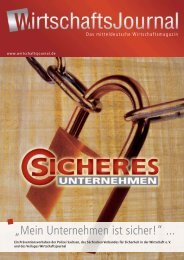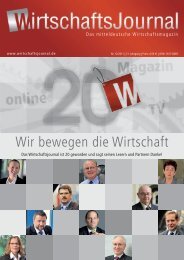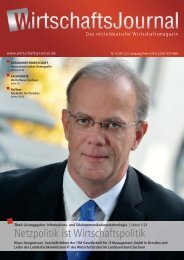E-Book Wirtschaftsjournal November 2011
E-Book Wirtschaftsjournal November 2011
E-Book Wirtschaftsjournal November 2011
Sie wollen auch ein ePaper? Erhöhen Sie die Reichweite Ihrer Titel.
YUMPU macht aus Druck-PDFs automatisch weboptimierte ePaper, die Google liebt.
VI<br />
SOLAR.MITTELDEUTSCHLAND<br />
Progress through collaboration<br />
The Solar Valley cluster strengthens the central-German solar industry and guarantees international leadership<br />
<strong>Wirtschaftsjournal</strong>: Dr. Frey, what sets the Solarvalley<br />
Mitteldeutschland Cluster of Excellence apart<br />
from other clusters?<br />
Dr. Peter Frey: First of all, our network brings together<br />
the solar industry in the three federal states of Saxony, Saxony-Anhalt<br />
and Thuringia. This is significant because all steps<br />
of the value chain - from silicon manufacture to the integration<br />
of finished modules into buildings - take place in<br />
Solar Valley. We have developed a coordinated technology<br />
program, which we have been implementing together for<br />
2 years. Within this context, companies, research institutes<br />
and universities are pursuing the goal of reducing production<br />
costs at each stage in the value chain and increasing<br />
the efficiency of the overall system. In addition, we are developing<br />
new applications for solar systems, such as direct<br />
integration into the building shell or as stand-alone power<br />
systems by means of combination with energy storage and<br />
smart grid technology. We also have an educational concept<br />
that is standardised across the states and we strive to<br />
orient ourselves internationally. It was for this reason that<br />
regional offices were established in Dresden, Erfurt and<br />
Halle. With this approach to innovation we are securing a<br />
position of technological excellence within the international<br />
market for the region of Central Germany. The goal of<br />
the cluster for the next ten years is to create 30,000 jobs<br />
in the Central-German solar industry and to establish solar<br />
power as an indispensable component within the overall<br />
energy mix. We are on the right path to achieving this.<br />
WJ: Nevertheless, the sector recently made headlines<br />
for the wrong reasons with losses in the millions<br />
- as in the case of Q-Cells, which was one of<br />
the top ten companies in the worldwide market. Is<br />
the Central-German photovoltaic stronghold now<br />
under threat?<br />
Dr. Frey: No. The industry is facing up to the challenges;<br />
the situation in Central Germany as a whole is stable. What<br />
we have experienced in recent weeks is more to do with<br />
price trends in the PV market. Once the Renewable Energy<br />
Law had been approved in Germany in 2003, the PV sector<br />
flourished rapidly. Installed capacity in Germany more<br />
than quadrupled from 2007 to 2010 alone. However, along<br />
with this, the market price halved. This is also linked to the<br />
strong competitive pressure from manufacturers in Asia,<br />
and particularly in China. Here production is taking place<br />
in enormous factories using very good equipment - prefer-<br />
<strong>Wirtschaftsjournal</strong> | Special SOLAR <strong>2011</strong><br />
Dr. Peter Frey Ende September in Erfurt auf der Veranstaltung „Photovoltaik trifft Maschinen- und<br />
Anlagenbau“.<br />
Dr. Peter Frey at the "Photovoltaics meets Machine and Systems Construction" event in Erfurt at the end<br />
of September. Foto: SolarInput e. V.<br />
ably from German machinery manufacturers. At present the<br />
market is shedding this overcapacity, which is also having<br />
a negative effect on turnover for some companies in Germany.<br />
However, there exist many companies that have invested<br />
successfully, such as Schott Solar, Masdar PV, pv crystalox<br />
solar and Bosch Solar Energy. The financial problems<br />
of individual manufacturers must not be viewed as applying<br />
to all.<br />
WJ: If you are saying that market prices have fallen,<br />
surely grid parity must be fairly imminent, is<br />
this so?<br />
Dr. Frey: Yes, absolutely. This is the upside of this stormy<br />
market trend. Photovoltaics have found their place in the<br />
renewable energy mix far sooner than even inside experts<br />
had expected. When the cluster was founded, we expected<br />
solar electricity to be cheaper than the grid by 2015. Based<br />
on the current trends, we will reach this target as early as<br />
by the coming year. If the trend continues, in two years'<br />
time solar electricity could be cheaper than even offshore<br />
wind energy.<br />
WJ: And how will the cluster and/or solar industry<br />
achieve this goal?<br />
Dr. Frey: First of all, manufacturers must reduce costs. We<br />
Central Germany has become<br />
established as a centre for the<br />
photovoltaic industry within the<br />
global market. In order to secure<br />
and further develop this position,<br />
photovoltaic companies, research<br />
and teaching institutions from<br />
three German states have forged<br />
a strong network in the form of<br />
the Solarvalley Mitteldeutschland<br />
Cluster of Excellence. In an interview<br />
with <strong>Wirtschaftsjournal</strong>,<br />
Dr. Peter Frey, CEO of Solar Valley<br />
GmbH, explains the background,<br />
objectives and potential of the<br />
cluster.<br />
�


